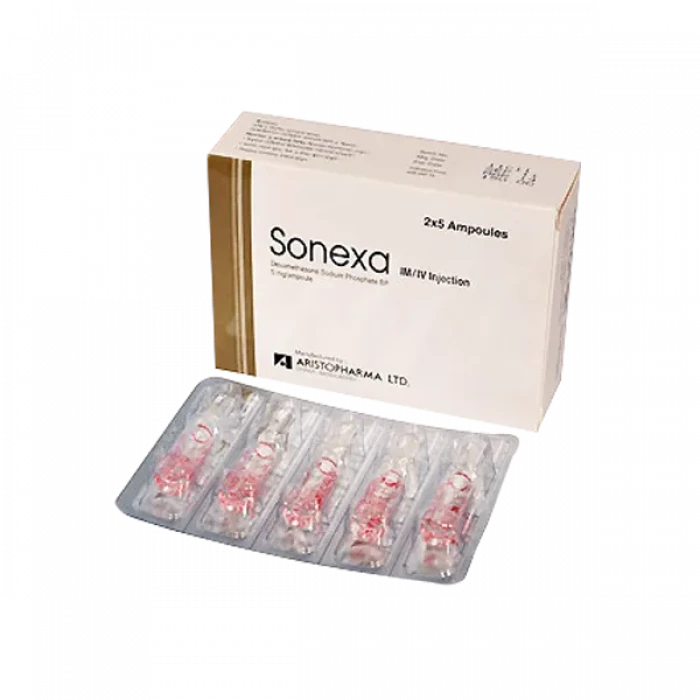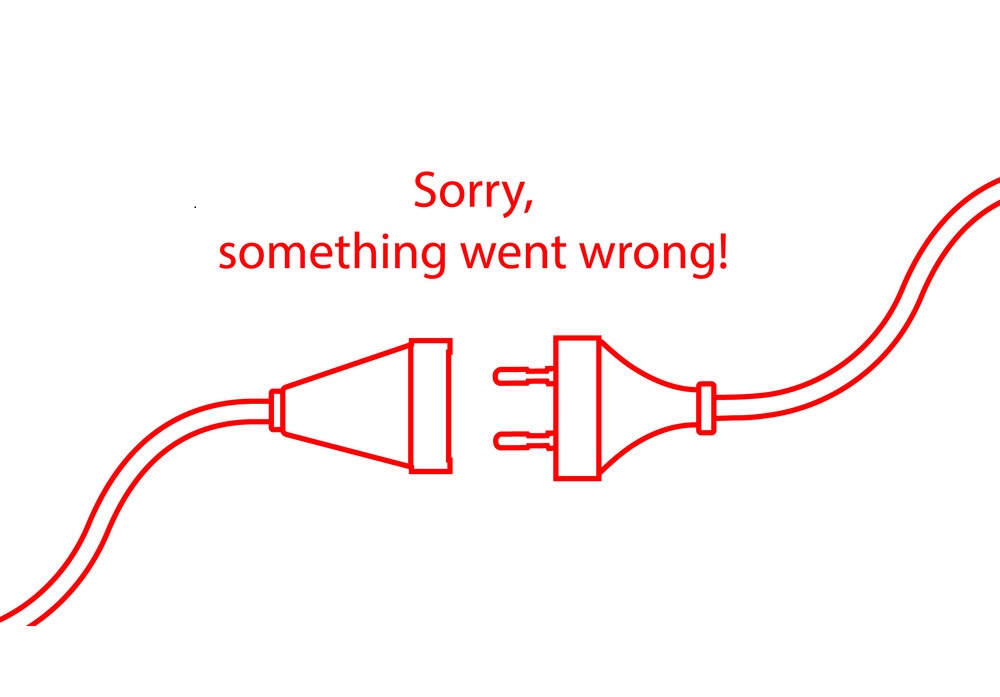
✔ 100% Authentic Product
👁️ Currently Viewing 1694
Sonexa-IM/IV Injection 1pc
Generic Name: Dexamethasone Sodium Phosphate
Manufacturer/Distributor: Aristopharma Limited
Discount
Price: ৳ 19
MRP:
৳
20
6%
Off

100% Genuine Products, Guaranteed

Safe & Secure Payments, Always

Fast, Secure & Efficient Delivery

Proper Packaging
 Cash on Delivery - All over Bangladesh
Cash on Delivery - All over Bangladesh Regular Delivery - 12-24 Hours, Dhaka City* Charge Tk.39-59
Regular Delivery - 12-24 Hours, Dhaka City* Charge Tk.39-59 Regular Delivery - 24-48 Hours, Other Cities* Charge Tk.99-110
Regular Delivery - 24-48 Hours, Other Cities* Charge Tk.99-110
 ফ্রি ডেলিভারিঃ - ৯৯৯ টাকা+ অর্ডারে, ঢাকা
শহরে
ফ্রি ডেলিভারিঃ - ৯৯৯ টাকা+ অর্ডারে, ঢাকা
শহরে ফ্রি ডেলিভারিঃ - ২৯৯৯ টাকা+ অর্ডারে, ঢাকার
বাহিরে
ফ্রি ডেলিভারিঃ - ২৯৯৯ টাকা+ অর্ডারে, ঢাকার
বাহিরে
100% Genuine Products, Guaranteed
Safe & Secure Payments, Always
Fast, Secure & Efficient Delivery
Proper Packaging
 Cash on Delivery - All over Bangladesh
Cash on Delivery - All over Bangladesh Regular Delivery - 12-24 Hours, Dhaka City* Charge Tk.39-59
Regular Delivery - 12-24 Hours, Dhaka City* Charge Tk.39-59 Regular Delivery - 24-48 Hours, Other Cities* Charge Tk.99-110
Regular Delivery - 24-48 Hours, Other Cities* Charge Tk.99-110 ফ্রি ডেলিভারিঃ - ৯৯৯ টাকা+ অর্ডারে, ঢাকা
শহরে
ফ্রি ডেলিভারিঃ - ৯৯৯ টাকা+ অর্ডারে, ঢাকা
শহরে ফ্রি ডেলিভারিঃ - ২৯৯৯ টাকা+ অর্ডারে, ঢাকার
বাহিরে
ফ্রি ডেলিভারিঃ - ২৯৯৯ টাকা+ অর্ডারে, ঢাকার
বাহিরে
✅ Description:
Indications of Sonexa IM/IV Injection
- Allergic state: through appropriate tests for routine treatment of asthma, atopic dermatitis, contact dermatitis, drug hypersensitivity, perennial or seasonal allergic rhinitis, and serum sickness, control stubborn severe or disabling allergic conditions.
- Collagen diseases: such as lupus erythematosus, rheumatoid arthritis, and so on.
- Skin diseases: herpetiform bullous dermatitis, exfoliative erythroderma, mycosis fungoides, pemphigus, and severe erythema multiforme (Stevens-Johnson syndrome).
- Endocrine disorders: primary or secondary adrenal insufficiency, congenital adrenal hyperplasia, cancer-related hypercalcemia, non-suppurative thyroiditis.
- Gastrointestinal diseases: regional enteritis and ulcerative colitis.
- Hematological diseases: specific cases of acquired (autoimmune) hemolytic anemia, congenital dysplastic anemia (erythroid) (DiamondBlack fan anemia), adult idiopathic thrombocytopenic purpura, and secondary thrombocytopenia.
- Tumor diseases: leukemia and lymphoma.
- Nervous system: acute exacerbation of multiple sclerosis, cerebral edema associated with primary or metastatic brain tumors, craniotomy, or head trauma.
- Ophthalmic diseases: temporal arteritis, uveitis, and ocular inflammation that do not respond to topical corticosteroids.
- Nephropathy: diuresis or relief of proteinuria caused by idiopathic nephrotic syndrome or lupus erythematosus.
- Respiratory diseases: beryllium poisoning, fulminant or disseminated tuberculosis when used with appropriate antituberculous chemotherapy, idiopathic eosinophilic pneumonia, symptomatic sarcoidosis.
- Rheumatic disease: such as acute gouty arthritis, acute rheumatic carditis, ankylosing spondylitis, psoriatic arthritis, rheumatoid arthritis, including juvenile rheumatoid arthritis (in some cases low doses of maintenance treatment may be required). It is used to treat dermatomyositis, polymyositis, and systemic lupus erythematosus.
- Others: diagnostic tests of adrenal hyperfunction, trichinosis with involvement of the nervous or myocardial system, tuberculous meningitis with subarachnoid block or impending block, and adequate antituberculous chemotherapy.
Pharmacology of Sonexa IM/IV Injection
Dexamethasone is a glucocorticoid that reduces inflammation by preventing white blood cell migration and reversing improved capillary permeability. It suppresses the normal response of the immune system.
Sonexa IM/IV Injection Dosage & Administration
In common, glucocorticoid dose depends on the seriousness of the condition and the reaction to the understanding. On the off chance that no positive reaction is famous within one or two days, a continuation of glucocorticoid treatment is undesirable. In inveterate conditions requiring long-term treatment the most reduced measurement that gives satisfactory, but not fundamentally total, help ought to be utilized.
For injection:
- You can administer dexamethasone intravenously (IV), intramuscularly (IM), or locally by injection. Dexamethasone injections can also be administered directly into the infusion line without dilution with an infusion fluid.
- Massive intravenous injections should be administered gradually over a few minutes.
- To avoid subcutaneous adipose tissue atrophy, deep intramuscular injections should be used for intramuscular administration.
- Given that glucocorticoids reduce infection resistance, intra-articular injections must be administered under strict aseptic conditions. Dexamethasone will remain active after being diluted with these infusion fluids for at least 24 hours (at room temperature and in daylight conditions). Ringer's solution, Hartman's solution
- The dosage of Dexamethasone depends on the severity of the condition and the response of the patient.
- For systemic therapy in adults, daily doses of 0.05-0.20 mg/kg body weight are usually sufficient. For emergencies (e.g., anaphylaxis, acute severe asthma, cerebral edema) substantially higher doses are required. An initial dose of 10-20 mg IV is followed by 6 mg IV or IM every 6 hours until a satisfactory result has been obtained. Thereafter the dosage has to be tapered off gradually.
For local therapy, the following doses are recommended:
- 2-4 mg intra-articularly for large joints and 0.8-1 mg for small joints
- 2-4 mg intranasally; 0.4-1 mg in tendon sheaths
- These injections can be given anywhere from once every 3-5 days to twice every 2-3 weeks.
Interaction
- Decreased potassium absorption may be caused by diuretics and/or cardiac glycosides. This is particularly hazardous for patients taking cardiac glycosides because hypokalemia can make these medications more toxic.
- Antidiabetic medications, such as the use of glucocorticoids, may affect glucose tolerance and the need for antidiabetic medications.
- Because they may increase the frequency and/or severity of gastrointestinal ulcers, non-steroidal anti-inflammatory drugs
- Oral anticoagulants, as the need for these medications, may change due to glucocorticoids.
- Combining glucocorticoids with medications that increase liver enzymes may reduce their effectiveness (such as rifampicin, ephedrine, barbiturates, phenytoin, and primidone).
- Because salicylate poisoning has been documented in patients receiving long-term glucocorticoid therapy and salicylate therapy, the dose of glucocorticoids should be reduced with caution in these situations.
- Antacids, particularly those that contain magnesium trisilicate, are said to affect how glucocorticoids are absorbed through the digestive tract. Therefore, it is best to space the doses of each medication as far apart as possible.
Contraindications
- Gastric and duodenal ulcers.
- Systemic and ophthalmic fungal infections.
- Viral infections, e.g., varicella and herpes genitals infections. Viral infections of the eye.
- Glaucoma.
- Hypersensitivity to corticosteroids
Side Effects
The following adverse reactions are related to long-term systemic glucocorticoid therapy.
- Endocrine and metabolic disorders: Cushing's syndrome, hirsutism, irregular menstruation, premature closure of the epiphysis, lack of secondary adrenal cortex and pituitary responses, impaired glucose tolerance, and negative nitrogen, and calcium balance.
- Fluid and electrolyte disorders: sodium and fluid retention, high blood pressure, potassium loss, hypokalemic alkalosis.
- Musculoskeletal effects: myopathy, abdominal distension, osteoporosis, aseptic necrosis of the femoral and humeral heads.
- Gastrointestinal effects: gastric and duodenal ulcers, perforation, and bleeding.
- Effects of skin diseases include acne, stretch marks, ecchymosis and ecchymosis, bruises, facial erythema, and impaired wound healing.
- Effects on the central nervous system include epileptic seizures, child pseudo-brain tumors (benign intracranial hypertension), mental disorders from euphoric manifestations, and papilledema.
- Glaucoma elevated intraocular pressure, and posterior subcapsular cataracts are ophthalmology side effects.
- Increased susceptibility to infection, and decreased responsiveness to vaccines and skin tests are all symptoms of immunosuppression.
Pregnancy & Lactation
Pregnancy Category C. There are no satisfactory and well-controlled considerations in pregnant ladies. Corticosteroids ought to be utilized amid pregnancy as it were on the off chance that the potential advantage legitimizes the potential chance for the hatchling. Glucocorticoids show up in breast milk. Mothers taking tall doses of corticosteroids ought to be prompted not to breastfeed.
Precautions & Warnings
- General: The lowest possible dose of corticosteroids should be used to control the condition during treatment. The reduction should be gradually reduced.
- Heart and Kidney: These medications should be used with caution in patients with congestive heart failure, hypertension, or kidney failure.
- Endocrine: Secondary adrenal insufficiency caused by drugs can be minimized by gradually reducing the dose.
- Gastrointestinal tract: Steroids should be used with caution in active or latent peptic ulcers, diverticulitis, intestinal anastomosis, and nonspecific ulcerative colitis because they may increase the risk of perforation.
- Musculoskeletal: Before initiating corticosteroid therapy, particular attention should be paid to patients at increased risk of osteoporosis (eg, postmenopausal women).
- Neuropsychiatry: Acute myopathy has been observed when using high-dose corticosteroids, with a higher incidence in patients with myasthenia gravis or concurrently receiving neuromuscular blockers (such as rocuronium). Mental disorders can occur, ranging from euphoria, insomnia, mood swings, personality changes, and severe depression, to frank psychotic manifestations.
Storage Conditions
Tablet: Store in a cool & dry place, protected from light & moisture.
Injection: Store below 30° C, protected from light. Do not freeze. Keep medicines out of the reach of children
⚠️Disclaimer:
At ePharma, we’re committed to providing accurate and accessible health information. However, all content is intended for informational purposes only and should not replace medical advice from a qualified physician. Please consult your healthcare provider for personalized guidance. We aim to support, not substitute, the doctor-patient relationship.






